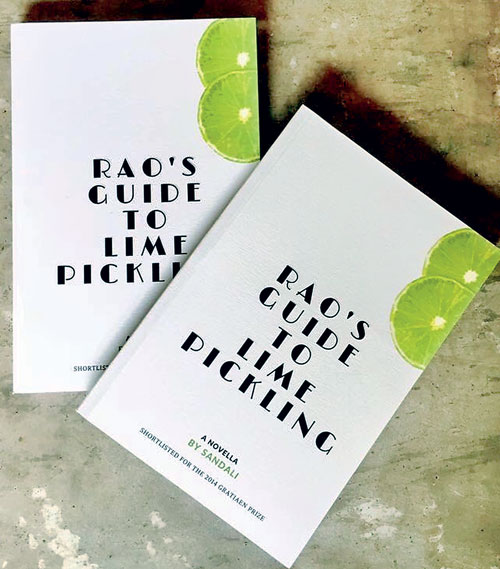Tuesday Mar 04, 2025
Tuesday Mar 04, 2025
Tuesday, 26 December 2017 00:10 - - {{hitsCtrl.values.hits}}
A novelist in the making
Sandali Handagama has been known by Sri Lanka’s film fans for her role as the rebellious but innocent and naive daughter of a family which was being torn apart by the personal incompatibility of the parents in the movie, Let Her Cry. Though it was her debut, she was able to win the attention of the critics as a promising supporting actress.
But, she has not been known at all as a young mathematician who has now turned a financial economist. She could have chosen any of these fields for a career. But her career has been in a completely different area: Teaching English to young students whose mother tongue has not been English. She has been a young woman inclined to testing many new specialities either as past-time or for a vocation.
Her latest testing ground has been the entry to writers’ world. In that area, her debut in the form of a novella – Rao’s Guide to Lime Pickling – has been released recently. In fact, this short novel has been one of the three theses she had submitted to the University of South Florida to earn her honours degree in mathematics in which creative art had been a minor component. The manuscript of this novella had been shortlisted for the coveted Gratiaen Prize in 2014. Now it has come out in book form to meet Sri Lanka’s wider readership.
No winners in wars, but losers
Rao’s Guide has been one of the few novels written on Sri Lanka’s 30 year long gruesome ethnic war from the side of an unwitting bystander belonging to the Tamil minority. Wars have always been painful to perpetrators of the war as well as to others who have been unwittingly dragged into them.
When wars are prolonged, the suffering of the civilians on both sides is also prolonged. They tear into pieces the usual harmonious social order on which societies had been proudly standing for long. Once that order is shattered, all those who are on this side or on the other side will lose everything they have built, acquired or established. As a result, it is a pack of victims all over and not winners and losers. 
The Buddha put this cogently when he said that nothing but pain can come from violence or war. In the long run, there are no winners but only losers. Human suffering, therefore, outlives any war. Hence, the end of the war does not mean the end of suffering. Just like an untreated wound takes a long time to heal, societies also take a long time to rebuild the shattered social order.
In this dilemma, creative minds seek to help the rebuilding process by digging into human suffering arising from war, positing them in minute detail and invoking sympathy among readers for the characters who had earlier in real life been branded as enemies. That change in mindset is the essential pre-condition needed to help people forget the past and agree on a reconciliation initiative that would take the pain out of their systems and cause the suffering to end. Sri Lanka which has been torn into many sectarian groups and cliques very badly needs such an enterprise today.
The art of decoding mysteries
The title of the book, Rao’s Guide to Lime Pickling, is a puzzle that cannot be easily comprehended. Wars or the victims of wars have nothing to do with lime pickling. For that matter, a guide to lime pickling is just a recipe, totally alien to violence or wars.
Sandali has thrown light on this puzzle in a two-sentenced blurb added to the back of her novella. It says: ‘A young man must go on a perilous journey across war ridden lands to honour those who sheltered him from a long and devastating conflict. His only guide is a mysterious little book left behind by a trusted friend that promises a recipe for pickled lime’.
Hence, lime pickling is a code and it is similar to codes used by the British writer Dan Brown in his novels. To decipher the code, Dan Brown has created his Harvard Professor, Robert Langdon, who is an expert on codes and symbols. The plot in the story is unwound to the reader when Langdon decodes the code and solves the puzzle.
Sandali does not have a Harvard Professor or an expert to do the job. In her work, a young, innocent and down to earth Tamil boy, Siva, does the deciphering of the code for the readers. He uses the code, Lime Pickling, to escape the war torn North of Sri Lanka at the end of the war in 2009 for safety among the majority Sinhalese.
Losing values amidst adversities
The story that covers the period from 1995 to 2013 is narrated by young Tamil boy Siva. On the day Siva is born in 1990, his father goes missing. The inquisitive Siva asks Mother about Father, but he always gets a blank response. Those in the family have more pressing questions to resolve than answering an inquisitive boy. Perhaps, they do not want Siva to learn of the truth. 
Truth, though it is a noble human value, is sometimes harmful to the person who learns of it. How will a son react when he learns what has actually happened to his father? It would turn him to a monster wanting to take revenge of those responsible for Father’s disappearance. Those in Siva’s family, especially his mother, it appears, do not want Siva to destroy himself by becoming a monster.
In fact, this has been the wish of Tamil civilians who have been caught in the conflict. Many have left the conflict areas, while others have taken risk to move to other countries. In peaceful situations, people may care for others. But when they have to struggle hard to save their own lives, the values dramatically change. Sandali has posited this creatively when she had described the scene involving Siva’s family leaving the village in the night for a safe place when they became victims of an aerial attack by armed forces.
Siva, a four year old boy, loves his pet cat, Iru, and wants to take it with them. But family values have now changed to treat a cat as a problem instead of something of value. Hence, despite Siva’s protests, they leave the cat behind to fend for itself. With an unyielding mother, Siva has no choice but to agree with his grandfather who puts some logic into his head. That is, the cat is quite capable of fending for itself and therefore is not harmed. Siva knows that it is a lie but chooses to believe that lie.
It is inspiration
that matters
Thus, Rao’s Guide is a story wound around this Tamil boy Siva who loses everything to the war – parents, education, relatives and above all, the hope of living as a Tamil. Throughout the story, he keeps a distance from the LTTE, the organisation that had claimed to be fighting for the rights of Tamils, but annihilated by the Sri Lankan government forces at the end. The story depicts the sad state of life of ordinary Tamils who do not wish to take a side in the conflict.
As a result, they are viewed as enemies by both sides. The title of the story comes from the title of a fictitious note book which Siva comes to possess after its owner, Rao, has been killed by some mysterious force, possibly by LTTE. Rao’s crime has been attempting to run away from war for safety in Colombo, the seat of administration of the Sri Lankan Government.
The title of the notebook ‘Rao’s Guide to Lime Pickling’ has been used by Rao to deliberately mislead any reader since it contained an elaborate plan by him to escape from Wanni to Colombo. That plan involves avoiding both the LTTE and Sri Lankan army checkpoints and patrols and landmines set by both parties to protect from the other.
Since Rao had been Siva’s only friend, confidante and guide, it appears that though the notebook contained no writing, it had served as the inspiration for Siva to escape to Colombo at the final stage of the war in mid 2009 and start a new life without his relatives but among his new Sinhala friends.
The agony of civilian Tamils
Sandali has explained in moving but powerful language the agony of people in Jaffna and Wanni who did not have a hand in the war. They are being pushed from place to place as internal refugees by both the LTTE and the Army.
Single mothers who have lost their husbands to the war – they have been either killed or abducted by both sides – had to undergo innumerable hardships to protect their sons and daughters from the evil that may fall upon them from all sides. They may be victims of Army reprisals, aerial bombings or attacks; if they survive, LTTE is having a hawkish eye on them to forcefully recruit them to its armed struggle.
Either way, their future is totally lost and mothers make valiant but futile attempts at protecting them from the evil. But their fate has been written on the wall and they all fall victim to the conflict which is not theirs. This is the powerful message which Sandali conveys through her novella.
Life among strangers
Siva being an innocent boy is unable to make an assessment of the situation on his own. He hears various stories about the war but his elders fail to appropriately apprise him of what is happening. His innocence and ignorance are depicted by Sandali through various episodes presented to readers in poetic language.
When the family had to leave Jaffna suddenly and relocate itself in Wanni, Siva who could not understand why it has happened, was angry with his mother. His anger is subdued only after his mother had remembered to bring with her his toy truck to Wanni. Despite the sickness, death, hunger and depravity all around, the innocent children manage to play various games of mischief totally oblivious of the fate awaiting them.
Then, Siva finds that he is not accepted to the circle of other children and his elders ignoring him. In this background, when he meets the older boy Rao, he immediately makes a crush on him and leans on him for guidance. Rao who also had lost his father in the ethnic clashes in 1983 keeps up to playing the big brother role and makes every attempt at keeping Siva happy. They share their secrets and ambitions in life. Then, when Rao is also killed, Siva finds that he has been left destitute in the world. After witnessing how his love is killed at the hands of the enemy soldiers and losing his mother, he escapes to Colombo. Sandali has given the hint that those who escape the wars are to survive and prosper even among the people who had been once considered their enemies.
A blank notebook serving as an inspiration
In the epilogue which relates to Siva’s story after he has been well settled among his Sinhalese friends in Colombo, the truth about the mysterious notebook is revealed. For the first time, a Sinhalese friend who peruses the Rao’s notebook shows the bitter truth to Siva that it is blank. Then only he realises that the notebook has simply been an imagination but when he had been struggling between life and death at the final phase of the war, an imagination also becomes an inspiration.
What he fondly remembers is Rao’s parting advice to him: ‘Use your imagination and escape’. This is a fundamental truth which Sandali has left for her readers. That is, if one has imagination, one also has the inspiration to do whatever one wants to do. But, imagination is nothing but creative thinking.
Thus, Rao’s guide is not for lime pickling but for being creative and converting adversity to prosperity. And, as Sandali has depicted, that has been the pillar on which modern civilisations stand. And if that pillar is not nourished, the perilous downward movement of modern civilisation is inevitable.
(W.A. Wijewardena, a former Deputy Governor of the Central Bank of Sri Lanka, can be reached at [email protected]).
Discover Kapruka, the leading online shopping platform in Sri Lanka, where you can conveniently send Gifts and Flowers to your loved ones for any event including Valentine ’s Day. Explore a wide range of popular Shopping Categories on Kapruka, including Toys, Groceries, Electronics, Birthday Cakes, Fruits, Chocolates, Flower Bouquets, Clothing, Watches, Lingerie, Gift Sets and Jewellery. Also if you’re interested in selling with Kapruka, Partner Central by Kapruka is the best solution to start with. Moreover, through Kapruka Global Shop, you can also enjoy the convenience of purchasing products from renowned platforms like Amazon and eBay and have them delivered to Sri Lanka.
Discover Kapruka, the leading online shopping platform in Sri Lanka, where you can conveniently send Gifts and Flowers to your loved ones for any event including Valentine ’s Day. Explore a wide range of popular Shopping Categories on Kapruka, including Toys, Groceries, Electronics, Birthday Cakes, Fruits, Chocolates, Flower Bouquets, Clothing, Watches, Lingerie, Gift Sets and Jewellery. Also if you’re interested in selling with Kapruka, Partner Central by Kapruka is the best solution to start with. Moreover, through Kapruka Global Shop, you can also enjoy the convenience of purchasing products from renowned platforms like Amazon and eBay and have them delivered to Sri Lanka.